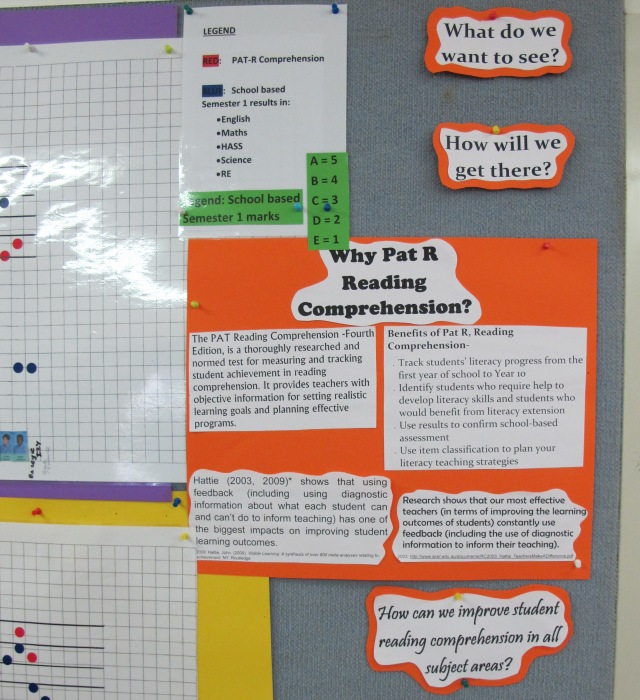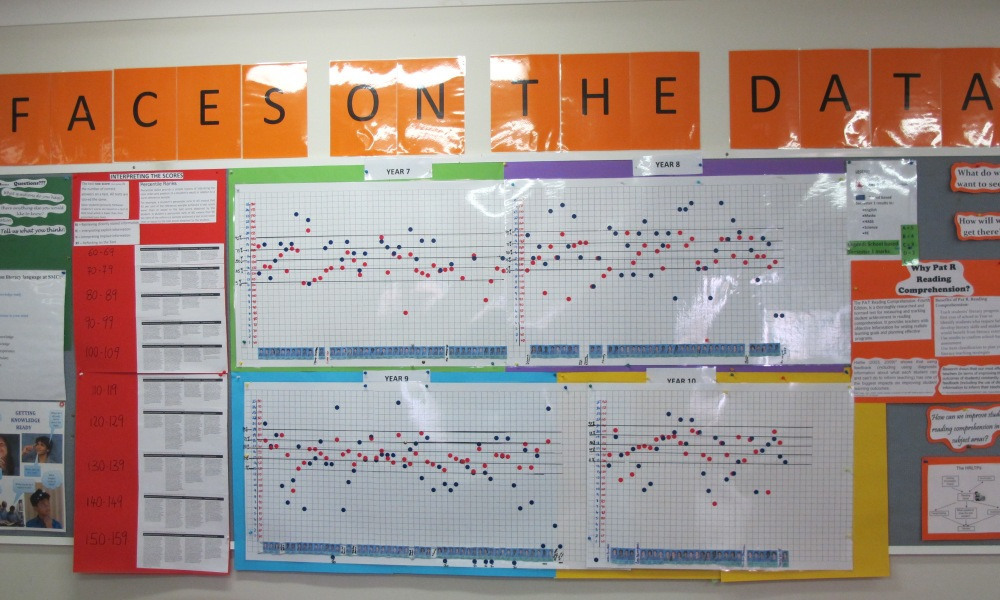Catholic schools in Western Australia are drawing upon the expertise of international curriculum consultant Lyn Sharratt to target whole school improvement.
One of the key strategies employed by Sharratt is the use of data walls, which visually represent student progress and allow staff to monitor change that occurs over time. Gabrielle Doyle, Director of Teaching and Learning at Catholic Education Western Australia, says that by using data walls, several schools are experiencing improved student outcomes. But she cautions that data walls need to be highly visible and ‘in your face' to truly have a lasting impact on staff.
‘You could have a magnificent data wall, but if no one talks about it and it doesn't have any impact – well that's just wallpaper,' Doyle says.
‘You actually want a messy, scrappy, data wall that causes people to argue and write notes on it and go away and find out more and come back.'
Having read Sharratt's books and learned about her work with the Catholic Education Diocese of Parramatta, Doyle thought her system would really thrive under Sharratt's leadership.
‘When I became Director of Teaching and Learning here, we spent a great deal of time analysing our long-term results for our system and noted that there were a group of schools who, for various reasons – it could be that they are regional schools, had a lot of new staff and transient populations, they could be a school that are in low socio-economic areas or they could be schools with new principals – but consistently over five or six years, the Year 9-12 results in literacy were not showing that students were making enough progress with the amount of time they spent in a school,' Doyle shares. ‘So I approached Lyn to see if she'd be prepared to work with us as an instructional coach, which she was!'
From there, Doyle and her team began approaching schools to invite them to take part in the project. She gathered a group of nine secondary schools and five primary schools to participate.
‘Logistically it's quite big because they all need to travel, so we decided that we would meet Lyn for two full days at the beginning and end of the year and go through the processes around her parameters and her processes, and we would support the schools centrally through the consultants that were here and through the regional offices.
‘Schools would develop a team led by the principal because this is all based on instructional leadership which sees the principal as having the greatest impact on teachers and teachers having the greatest impact on students. That's based on the instructional leadership model –Viviane Robinson's work from the University of Auckland.'

[Data walls visually represent student progress and allow staff to monitor change that occurs over time. Image supplied.]
Doyle and her team also meet once a week to discuss an individual school and case manage them. ‘We meet with what's called a School Improvement Advisor and a School Support Consultant, myself as Director and the Team Leader of Teaching and Learning, and we have a 15 minute conversation around one of those schools that we think is worthy of a conversation.
‘So, either a school that we need to help differently, or a school [that's] doing really well – because the School Improvement Advisor and School Support Consultants select the school. They say, “we think this school is stuck or vulnerable” and we have a conversation starting on the strengths of the school, what are they doing really well? What piece of data are we analysing? What does the data tell us? And the important part is, how do we change what we're doing as consultants to assist that school better? And that's how we do that.'
Doyle says her team is in negotiation with a university to formally evaluate the program. They'll also be looking closely at NAPLAN data, Catholic education system data and Year 12 Western Australian Certificate of Education (WACE) data.
‘We went and spoke to schools to look at what data they had as well, and some of them agreed with it “yes, you've got our picture right” and others said “no, that's only one snippet”.
‘And that's a really important thing around the data walls and data, it is only ever one piece of evidence. It is never the full story … you must continue to ask questions about your data and you must continue to find other sources of data.'
While the data walls have been largely based on Sharratt's work in this instance, Doyle says it is certainly something that can be emulated in other school settings.
‘Certainly the use of the data wall is part of Lyn's work but some schools who are not in this cohort use data walls in a different way or use data walls very effectively, so it's not just the cohort schools,' she says.
‘Each school's journey has been very different … for instance we have a primary school that has over 450 students on their data wall looking at reading levels. I've seen high schools that have data walls for all their Year 8 and their Year 7 cohorts. In Parramatta I've seen data walls for an entire school of 1200 students, so really it's doable but it's never a simple process but if you use them well [you] get good discussions out of them.'
Doyle speaks highly of the impact the program is having on the schools involved.
‘It's been phenomenal to have someone of Lyn's ability and talent. She's very inspiring and we've dovetailed – Lyn doesn't just work with the schools, she works with our consultants as well. We've really worked hard to build up the capacity of our consultants to be able to work with schools, to develop capacities of principals who must lead this, and develop the capacities of the teams in the schools.'
And while Doyle advocates for the use of data walls in schools, she does caution against using them in electronic form. ‘I think we have to be really careful about calling them [the electronic formats] “data walls” because the purpose of a data wall is that it is the moral imperative of that student in your face and you can't close the lid of the laptop and turn it off.
‘It's really about that moral imperative – that it is your responsibility to help this student or these students and you need your colleagues to do that. So, whilst I think you can get some great data on laptops and create learner profiles and all that sort of stuff, you need the psychological and cognitive and emotional push of that face staring at you, saying “you need to do the best by me”.'
Do you use data walls in your school setting?
How often do you have conversations around the data? Do you agree action points?
As a school leader, how do you ensure these data walls have a lasting impact on staff?



